History is a story of people. An exhibit about the construction of a warship could easily devolve into a discussion of technology or mechanics, and edge out the human dimension. And yet it is those personal stories that create a connection across the centuries. The troubles and challenges faced by Americans of the 1790s are not so different from those we encounter today. Their worldview may have differed, but the vagaries of human nature remain the same.
People therefore take center stage in our interpretation of Constitution’s past, and recent exhibits here at the museum have attempted to call out their personal histories, not only in words but graphically through the use of life-sized, full-color cutouts.
A history museum must shoulder the burden of presenting an accurate portrayal of the past. All interpretation is filtered through our own biases, of course, and informed by our own predilections, but when it comes to recreating the material world of the past, we have a duty to exercise a great deal of care in how we do it.
For the “Forest to Frigate” figures, we faced a number of challenges. All of these cut outs represent people of the mid-to-late 1790s. Some of them are well-known historical figures, others are so obscure we don’t even know their names. Nevertheless, we have dressed them with an attention to detail that deserves some explanation.
One can’t simply go to a costume shop and buy clothing from the 1790s. Everything the models wore had to be hand crafted. The last decade of the 18th century was a time of change in fashion. Older or more conservative men clung to the fashions of earlier decades, but many young men embraced more fashion-forward styles. After examining original garments to discover their construction techniques, and surveying contemporary portraits and other artwork, we were able to draft patterns for the coats, waistcoats, breeches, trousers, and shirts for the models to wear.
Next came the difficult task of sourcing the proper materials, and then cutting and sewing the garments together. Because the figures were going to be photographed in high resolution, even small details had to be precise. There were no sewing machines in the 1790s, of course, so all the visible stitching had to be done by hand, including many dozens of buttonholes.
The hats, too, had to be specially crafted. In the 1790s, the “round hat” (what a modern person might call a “top hat”) began to become fashionable for day wear, but plenty of men clung to the old fashioned cocked hat with its upturned brims. As the decade progressed, these hats tended to become larger, and consequently more expensive and difficult to make.
Before 1818, hatters made their products on cylindrical wooden forms called “blocks.” Modern hats are made on oval blocks, but the round historical blocks required hatters to stretch the crowns to fit the wearer’s head. This action caused the hats’ brims to droop or curl in unique ways, and lent period hats their distinctive profiles.
All told, the creation of the ensembles required more than 200 hours of work. That number doesn’t include the countless hours it took to make the clothing provided by our dauntless models, many of whom are talented craftsmen themselves. Without their help- and their historical wardrobes- this project could never have been finished.
The exhibit opens with the figure of President George Washington. No longer a general leading the Continental Army, he is now the first president of the United States. The model, John Koopman, plays Mr. Washington at historic sites up and down the East Coast. He wears a reproduction of the President’s first inaugural suit, an ensemble that was symbolically tailored from American-woven wool broadcloth.


The visitor next encounters Joshua Humphreys, the Philadelphia shipbuilder responsible for designing the country’s first six frigates. There is no known portrait of Humphreys, or any detailed descriptions of his appearance. He was a “disunited” Quaker, and while he no longer attended their meetings, it is likely his dress was influenced by the Quakers’ plain style. In this case, however, the gilt coat buttons probably point to an opulence born of dissent. The model, Henry Cooke IV is a renowned tailor of historical garments and the proprietor of Historical Costume Services. While we provided his coat and hat, he made his own silk “small clothes”- that is, waistcoat and breeches, as well as stockings and shirt. He holds an original pair of dividers, a tool long associated with the shipwright’s trade.
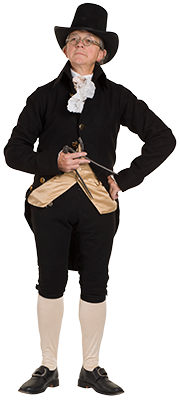

Looking at a finished ship perhaps belies the huge logistical effort it took to construct it. The next figure is Henry Knox, veteran of the Revolution and now the Secretary of War. When the frigate-building program began, there was no Navy Department, and the War Department handled all the contracts for materials and armaments. The model, Jim Hollister, is a Revolutionary War historian and a ranger at Minuteman National Historical Park– the very place where the Revolution began. He wears the uniform coat of a general (copied from Gen. Anthony Wayne’s original coat), along with his own buff smallclothes. He’s pouring over a ledger in which he’s enumerated the huge amount of timber required to build the ships.


In fact, the procurement of timber was one of the most labor-intensive operations associated with ship-building. Joshua Humphreys insisted the ships should have their frames constructed of live oak, dense, rot-resistant wood that grows in coastal areas of the American south. The government hired sixty axemen and thirty ship carpenters from New England to cut and shape the timber “by pattern moulds.” These men were skilled with the axe, but unfortunately the huge trees grew in an unhealthy environment. Even though they delayed their arrival in Georgia until the fall, by spring time a number had died of fever, some had deserted, and the rest headed home. We don’t know the names of most of these men, so this figure stands in for the Massachusetts and Rhode Island men who journeyed south. The model, Niels Hobbs is himself from Rhode Island, a marine biologist, and a superb historical tailor, among many other talents. He wears a red shawl collared vest so popular in the late 1790s, as well as a striped knit cap, common among laboring men of the period.
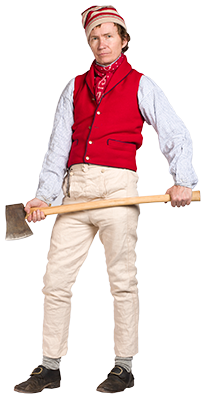

The figure laboring beside him represents the great and bitter irony underlying the story of ship. The frigate Constitution was designed as “a powerful agent of national justice,” as Naval Constructor George Claghorn put it, but for many of the men who worked on her, there was neither justice nor freedom. Before the northern carpenters arrived and after they went home, local enslaved Africans were hired to cut and transport the live oak timber. The names of these men have also been lost to history, but their skills provided much of the timber that built the ships. The model Aaron Wilson is a professional model and an actor. He wears a pair of coarse trousers and a shirt and wields an original hewing axe.
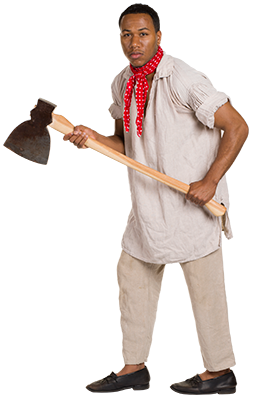

With the timber procured and cut to shape, the pieces had to be joined together with various bolts, spikes, and nails. Many of the copper fastenings for the ship were ordered in England, but Boston’s Paul Revere had a hand in altering some and manufacturing many others. He learned the secret of making malleable copper that was so hard it would “drive like iron.” He also made a variety of ship fittings and the ship’s first bell. The model, Gary Gregory is an expert in another early American technology- printing. He’s the brains behind The Printing Office of Edes and Gill, a reconstructed colonial print shop open for business beside Old North Church. He’s wearing a suit made by Henry Cooke, a greatcoat and hat made by us, and he’s holding an original copper fastener from the ship.
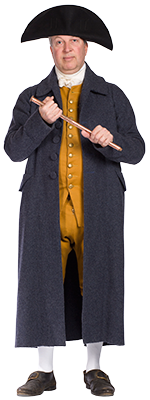

While Revere and his workers made the ship’s fasteners, it was the shipwrights at Edmund Hartt’s shipyard who drilled the holes and drove the bolts through many feet of rock-hard wood. Unfortunately, the payrolls for the yard have not yet come to light, so once again, many of the men who laborer there remain anonymous. We do know of one however. Jean Baptiste LeCourtois came to this country from France or the West Indies in the early 1790s and found a job at the shipyard. In 1797 he moved to Norfolk, Virginia and sought to become an American citizen. George Claghorn provided him with a favorable recommendation: “Jean Baptiste LeCourtois has worked in this yard as Carpenter on the Frigate Constitution for the term of twenty months during which time he has conducted himself as a Sober honest upright Man and has performed his duty with alacrity….” The model, Justin Squizzero, is a fine tailor, a stone cutter, an artist, and a professional weaver. He co-operates Eaton Hill Textile Works, and so of course wove the very fabric his waistcoat is made from. He holds an original spoon bit auger of the type used on the ship.
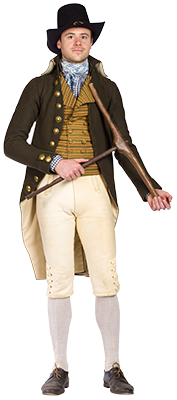

Finally, the ship is assembled and ready to launch. This should have been a proud day for Naval Constructor George Claghorn, but miscalculations and problems with the launching ways meant it would take two more attempts before the ship entered her “native element.” Claghorn’s face betrays his consternation. As one witness to the failed launch attempt wrote, he “actually appeared to have lost flesh in eight and forty hours, from mortification and vexation.” The model, David Schultz, is a long-time reenactor. He holds an original carpenters bevel and wears newly-fashionable knit pantaloons and hessian boots, a shad-bodied coat with a stand and fall collar, and a striped velvet waistcoat – just the thing for a ship launching!
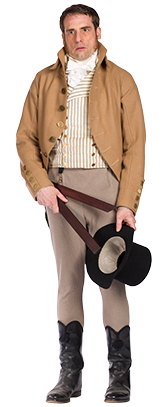

These are the newest characters to grace the USS Constitution Museum’s galleries. In the end, all of this attention to detail would have been wasted effort without the superlative photography of Greg Cooper. He has worked with us many times before, and his skill at getting just the right shot is remarkable.
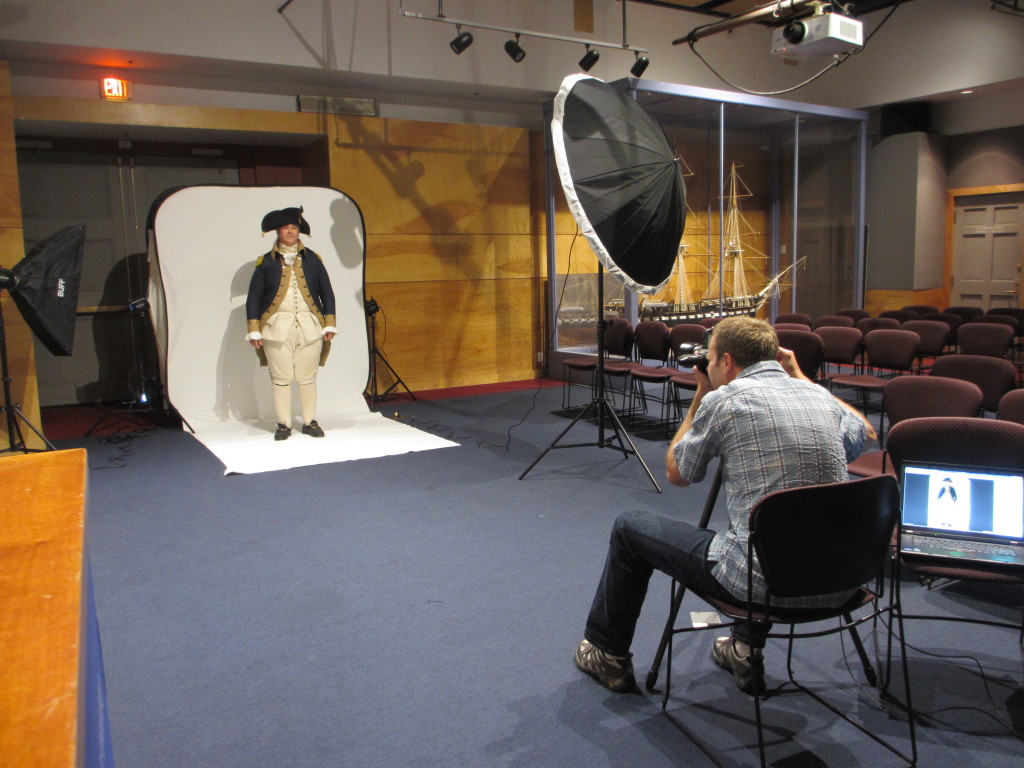

Now you have to come visit these folks in person. They’re waiting to tell you more of their stories.
The Author(s)
Matthew Brenckle
Research Historian, USS Constitution Museum
Matthew Brenckle was the Research Historian at the USS Constitution Museum from 2006 to 2016.
